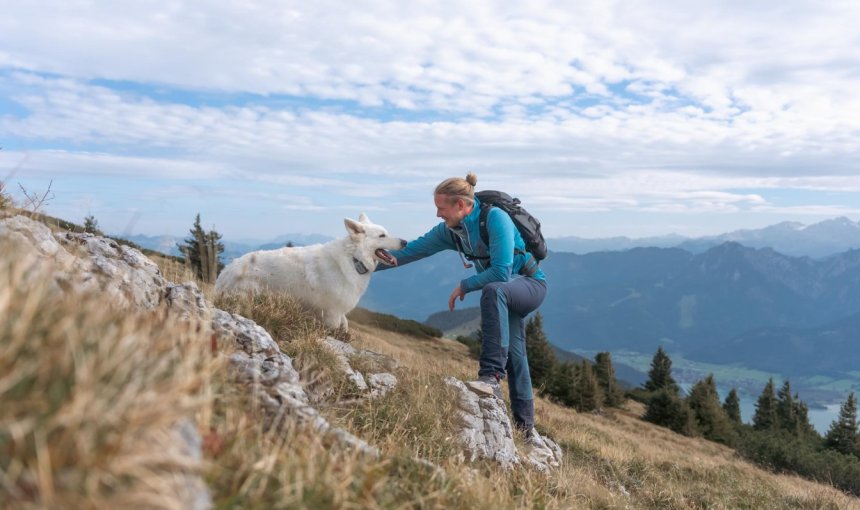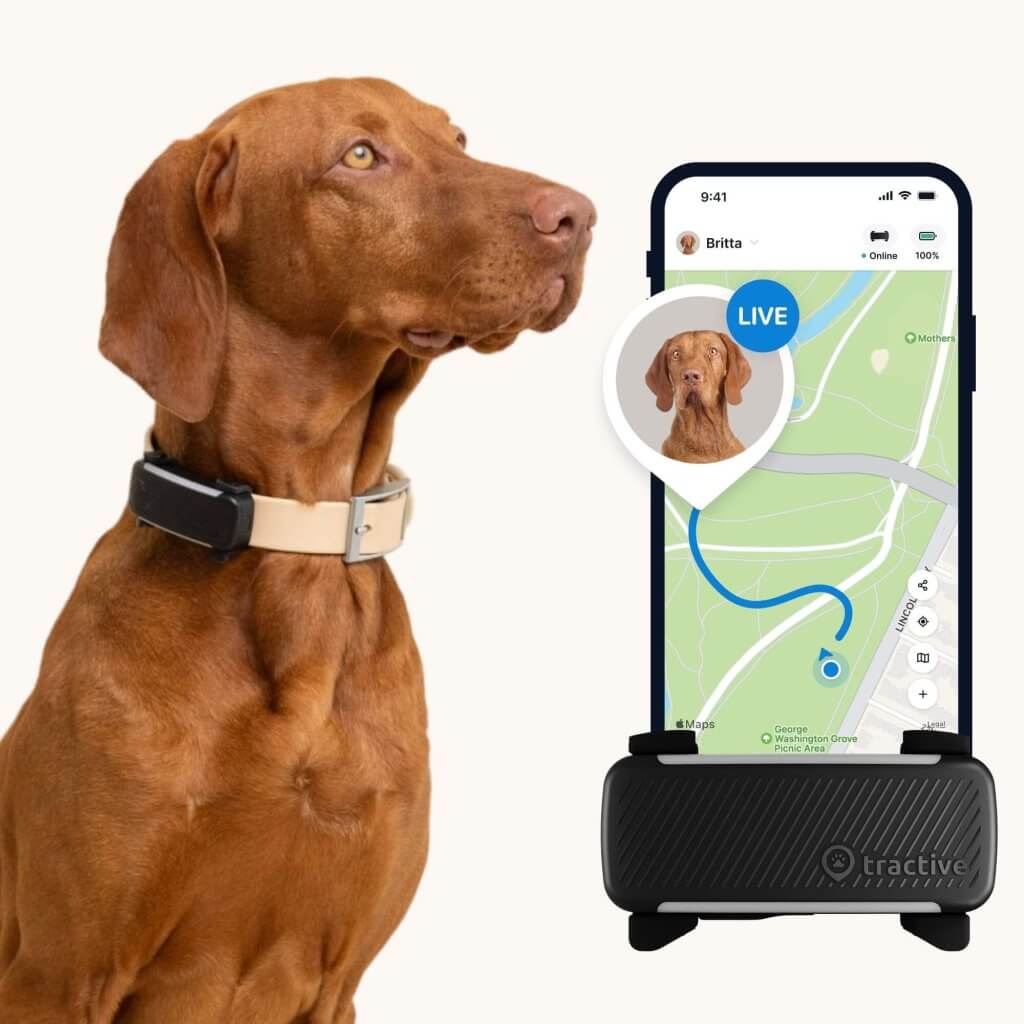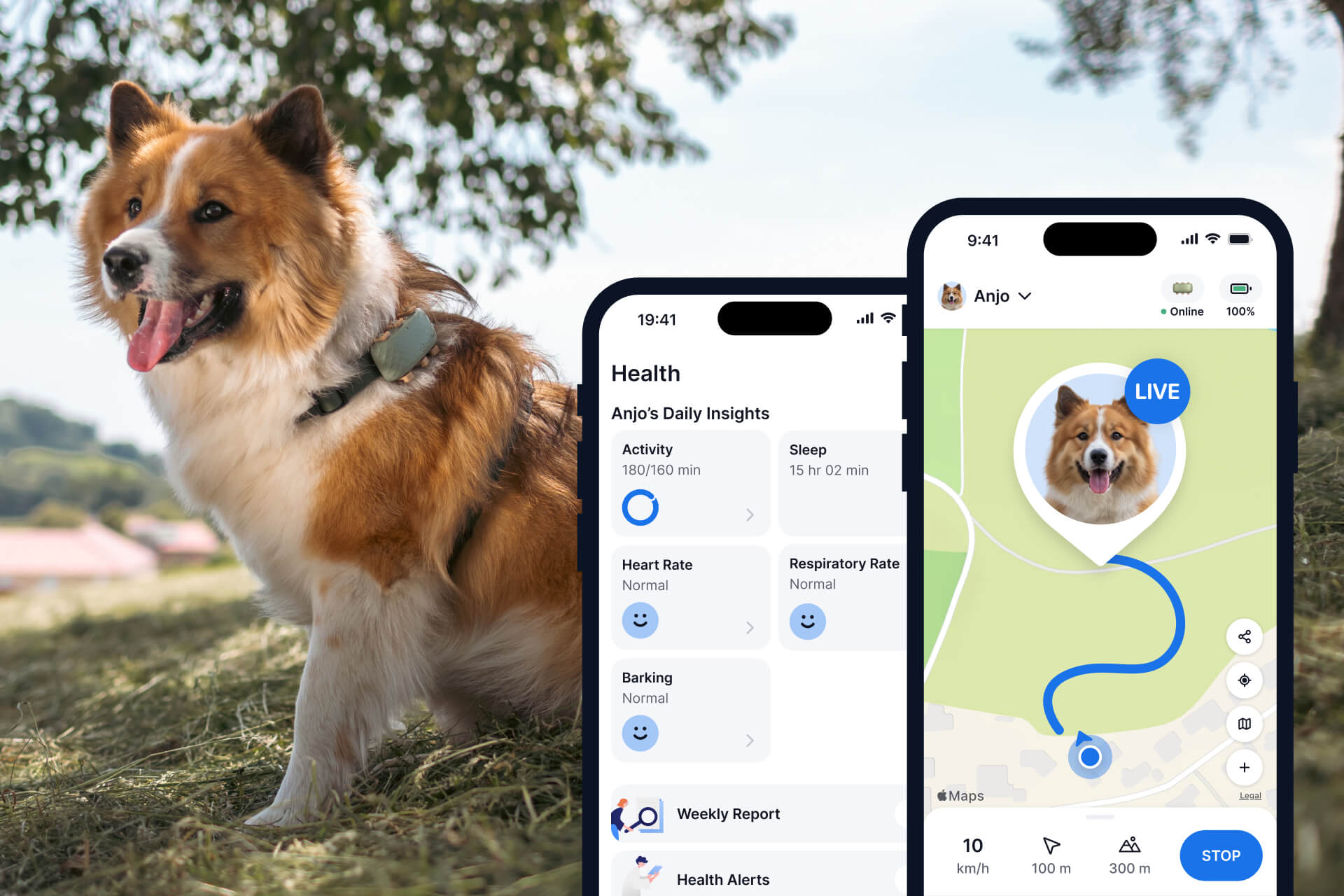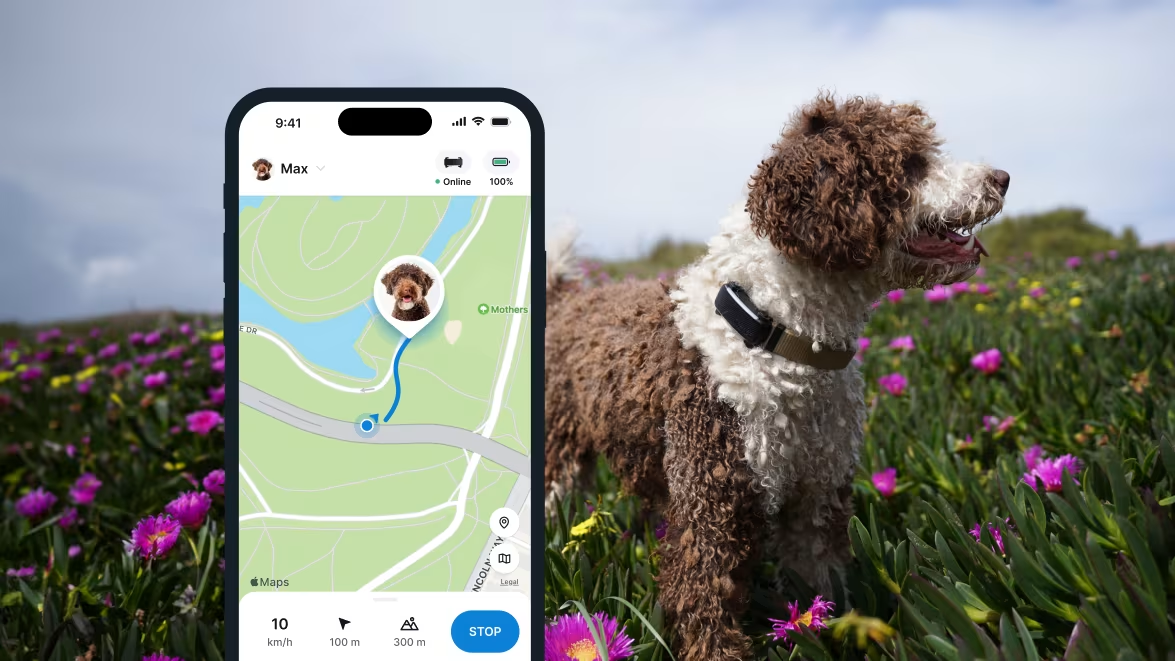Hiking With Dogs: Tips For A Stress-Free Adventure
Hiking with dogs can be a world of fun - or a nightmare, depending on how well-prepared you are. Here's all you need to hit the trails, stress-free.

Ready to get out there and go hiking with your dog? You’ll need to have the right equipment and proper training, and know the right safety tips and precautions. Plus, why a dedicated smart dog tracker built for rough and tough dogs can be your second best friend when out in the wilderness.
Key Takeaways
Always carry the essentials: plenty of water, snacks, a dog-specific first aid kit. Keep your dog on a leash to prevent unexpected run-offs.
If your dog is new to hiking, begin with shorter, manageable hikes. This helps build their endurance and acclimates them to the trail environment.
Make sure to pick trails that are dog-friendly. Some areas have restrictions, so it’s essential to ensure your chosen path allows dogs.
A Tractive smart dog tracker provides real-time GPS tracking that works across an unlimited range, so you can keep an eye on your dog’s location throughout the hike. Meaning peace of mind during your outdoor adventures

Always know your buddy is healthy & safe
Read moreEssential do’s when hiking with dogs
- Keep your dog on a leash
Besides being a legal requirement in some countries, hiking with dogs on a leash can help prevent them from bolting. With one, your dog at least has some idea that they should toe the line and stay within sight. In case yours is still unfamiliar with them, check out our post on leash training a dog. - Bring plenty of water and food
In the wilderness, there’s no shortage of poisonous plants like mushrooms which might be fatally toxic for your dog if they take a bite out of them by accident. Carry along healthy snacks (like kibble) your dogs can safely eat – and avoid any foods that should be off-limits for them. Watch out though: your trail mix might include bits of chocolate or rains that can poison your dog! - Carry along a dog first aid kit
There’s always the risk they might snag a paw on a rock or crash into a bush. Which makes a dog first aid kit a potential lifesaver in these situations. Including items like gauze, medical tape, antiseptic solution, and hydrogen peroxide. - Use a smart dog tracker as an emergency measure
Whether it’s due to prey drive, spooking from a loud sound, or just curiosity – there’s always the chance your dog might run off during a hike. But with a smart dog tracker with GPS tracking strapped to their collar, you can follow their every move in real-time, plus over an unlimited range. So you can hike, stress-free, knowing you have an extra layer of security for your outdoor adventures.

Follow your dog anywhere
Get real-time location information, wherever they go. And find out when they try to make an escape, or just when they go somewhere they shouldn’t, with Virtual Fences.
Is your dog ready for a hike? What to consider
- Your dog’s overall health
If your dog is sick, in pain, disabled or suffering from allergies, then avoid tiring, long hikes. A short walk outside or a romp around the dog park (if they are able) might be a better alternative. - Age & size
Almost any breed weighing over 33 pounds can be a good trail dog. Just keep in mind that small dogs have to take a lot more steps to cover the same distance and may need a lift where a larger dog would not. For dogs older than 10 years, keep the route easy and stick to shorter hikes (if they do any hiking at all). Puppies need to avoid over-exercising, so a half-day hike is generally better for them. - Behavior, training & recall
Make sure your dog displays good behavior towards others (especially towards children), has a handle on their prey drive, and follows your command before hiking together. Having good recall can be a potential lifesaver while out in the wilderness. - Whether your dog is neutered
The mating instinct can drive your dog to chase every female dog he sees. Before you two head outdoors, it’s the responsible choice to get them neutered or spayed to avoid this kind of roaming behavior. - Your dog’s temperament
A fearful dog might bolt at the slightest sight or sound. Likewise, one that’s endless curious and inquisitive and needs to stick their nose into just about anything!
How to prepare for hiking with dogs
- Vaccinations & checkups
Make sure that your dog’s vaccinations are up to date before you hit the trail. It’s also a good idea to have your vet give your dog a health check to make sure they’re fit for hiking. Double-check whether your dog needs any preventative medicines, especially against fleas and ticks. - Obedience training
Your dog should respond all basic obedience commands necessary to be safe in the mountains. For example, coming to you when called, stopping or staying when you say so, walking by your side as needed, and staying calm around wild animals. - Socialization
With all the narrow (and potentially dangerous) trail sections you might end up sharing with fellow hikers, it’s key that your dog is super-socialized and knows how to behave around other dogs and humans. If your dog is aggressive or overly protective, they probably won’t make a good hiking buddy. - Endurance training
Your dog’s physical fitness level should be on par with the difficulty of your planned hike. Ease into your new hiking habit with a small, easy hike of an hour or so, and gradually increase the time on the trail. A high energy level after a hike is a sign you can go for longer next time. - Pick a dog-friendly hiking trail
In the US, dogs are not allowed on many hiking trails, so read up on local regulations before your trip. These National Parks, on the other hand, are dog-friendly. Choose trails with soft, leaf- or needle-covered terrain. These are best for sensitive dog paw pads. Avoid paths with sharp rocks, off-trail routes with steep drops, or any surface that gets very hot.
Essential dog hiking gear
Safety gear
- Collar & ID tag
Along with your dog’s collar, always make sure your dog can be properly identified with ID tags – your phone number should be easy to read so someone can call you immediately if they find your wandering dog. - Harness & leash
Depending the trail, you may need to keep your dog leashed most of the time. Choose a lightweight yet durable leash or consider a hands-free waist leash. A harness will make walking on the leash more comfortable for your pal. - Safety light
This often-overlooked item can help you keep an eye on your dog at all times, whether it’s after sunset or during a night-time potty break. You might also want to use a reflective dog collar or vest to increase visibility. - GPS dog tracker
When you’re out in the wilderness, don’t rely on a Bluetooth item finder like AirTag to help you locate your lost dog. It probably won’t work. You can instead follow your buddy’s every step in real-time with a Tractive smart dog tracker.

Other important gear
- Dog pack
This is like a dog backpack your furry friend can wear on the hike to help carry some of the gear. Be sure to get a pack that fits your dog correctly and has a top handle (for keeping your dog closeby as needed). - Dog towel
On your hike, your canine buddy is very likely to get muddy, wet or both. Have a hiker towel on hand to clean muddy paws and at the same time, keep your tent clean. - Dog bed
If you’re camping overnight in the woods, consider what the best sleeping for your dog is. You might need to invest in a larger tent or a comforter for your doggo. - Dog booties
These can help protect your dog’s paws when the terrain is rough, hot or icy. Dog booties will minimize the risk of injury to your dog’s feet during a hike. They will also prevent sore paws, especially when your canine is new to hiking. Make sure your dog is used to wearing them, and get dog shoes with good grip. - Dog (rain) coat
A dog raincoat might seem silly at first, but it can play an important role in preventing frostbite during rainy weather. - Nail clippers
Trim your dog’s nails regularly, so they won’t destroy your tent or other hiking gear. - Toys
These are optional, but may come in handy on a long journey with your furry friend. Consider brining a ball, frisbee, cloth toy for tug-o-war or chew toy for some fun.
Hazards on the trail
- Exhaustion
Watch your dog’s breathing, heart rate, and behavior to make sure they’re not pushing it too hard. Limping or rapid heart rate may be a sign that you need to take more breaks or end the hike sooner than later. - Bad weather
Winter hiking weather like snow and ice can be hard on dog paws. It could even lead to hypothermia (freezing) in extreme cases. On the other hand, high temperatures and direct sunlight also pose risks such as heat stroke and sunburn. Make sure choose a cool day to hike with your dog, pick trails offering shade, limit sun exposure, and take plenty of water breaks. - Wild plants
Some wild plants can pose a serious risk to your dog. From grass awn danger to poison ivy and other toxic or irritating plants, do yourself and your pup a favor and don’t let your dog chew wild plants. - Wildlife
Which you want to avoid your dog picking a fight with. Including bears, snakes, mountain lions, coyotes, raccoons, wolves, porcupines, or even deer. - Water dangers
Strong undercurrents can make it difficult for your dog to swim to safety. Likewise, natural bodies of water might contain bacteria which might infect your dog. To be safe, treat backcountry water before letting your dog drink it.4 - Baited wildlife traps
Your dog may encounter traps set for wild animals if they venture too far off trail. Similarly, keep your dog by your side to avoid encounters with hunters in the hunting season. - Cliffs and dangerous trails
Always keep your dog leashed if there is a chance that they could fall – which on a mountain hike, is more often than you might expect. Similarly, never attempt rock climbing with your dog.
Ready to hike stress-free with your dog?
Here are some final things you may want to consider, including trail etiquette when hiking with dogs:
- Follow the local laws
Make sure you choose a hiking trail that dogs are allowed on. Also consider microchipping your dog – since most countries and some US states mandate them for all dogs. Similarly, check whether your area requires you to walk your dog on a leash. - Start slow
If your dog is new to hiking, shorter trips might be better to avoid overwhelming them. Plus, tread gently – don’t let your dog’s curiosity cause damage to local wildlife. - Give way to fellow hikers
Keep your dog by your side while you let them pass – you never know who might be afraid of dogs. - Avoid dangerous trails with steep cliffs or climbing required. Similarly, steer clear of areas heavily frequented by horseback riders and mountain bikers.
- Break often for water and snacks. Keep an eye on your dog’s activity and how quickly they tire.
- Take any trash you create with you; pick up after your dog’s waste or bury it. As a rule of thumb: leave only paw prints, take only pictures.
- Consider attaching a smart dog tracker to your dog’s collar. So you can see where your dog is at all times, allow them the freedom to roam, and enjoy your hike, stress-free.

Did you find this guide useful? Then share it with a trail-loving friend and let’s help build a safer, kinder world for our furry friends together.



